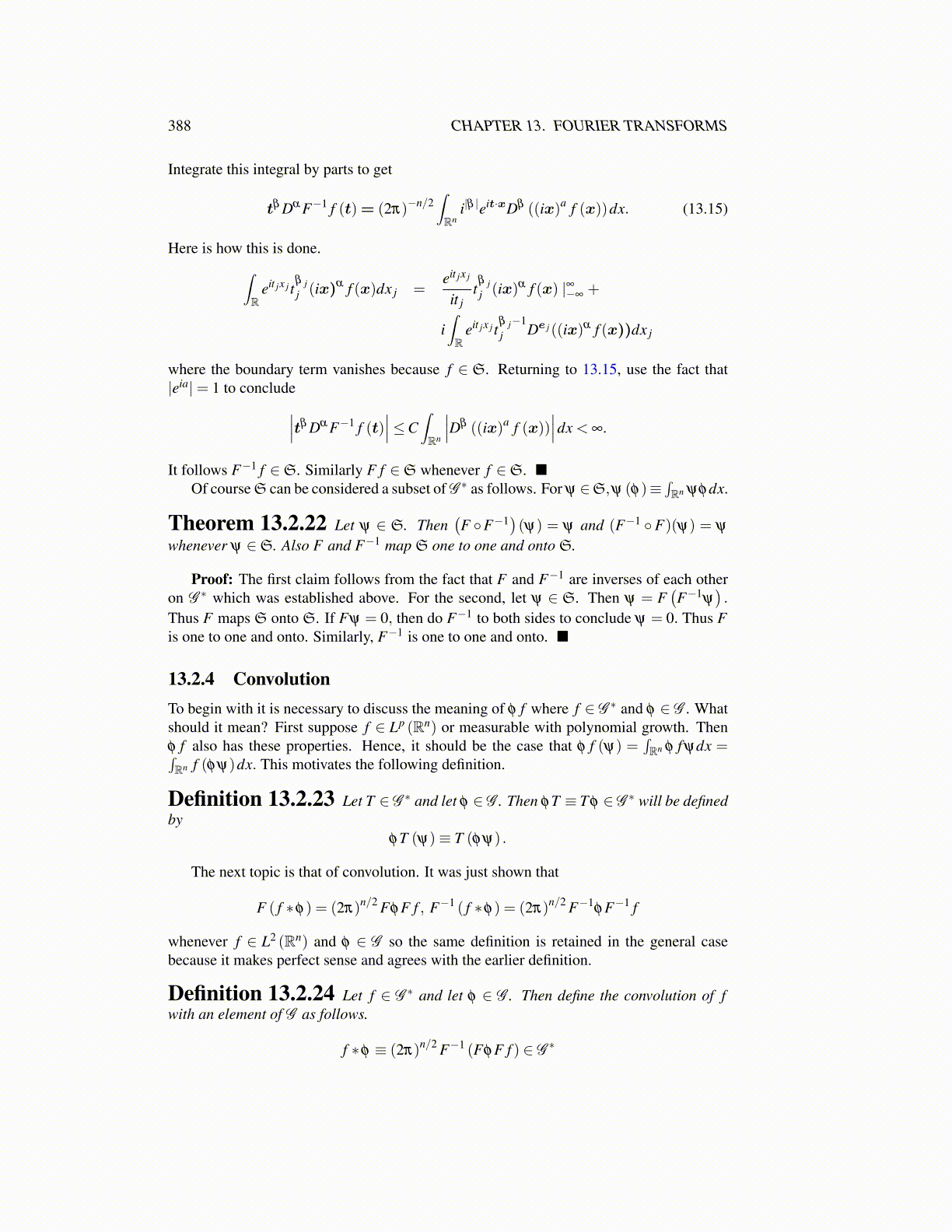
388 CHAPTER 13. FOURIER TRANSFORMS
Integrate this integral by parts to get
tβ Dα F−1 f (t)= (2π)−n/2∫Rn
i|β |eit·xDβ ((ix)a f (x))dx. (13.15)
Here is how this is done.∫R
eit jx j tβ jj (ix)α f (x)dx j =
eit jx j
it jtβ jj (ix)α f (x) |∞−∞ +
i∫R
eit jx j tβ j−1j De j((ix)α f (x))dx j
where the boundary term vanishes because f ∈ S. Returning to 13.15, use the fact that|eia|= 1 to conclude∣∣∣tβ Dα F−1 f (t)
∣∣∣≤C∫Rn
∣∣∣Dβ ((ix)a f (x))∣∣∣dx < ∞.
It follows F−1 f ∈S. Similarly F f ∈S whenever f ∈S. ■Of course S can be considered a subset of G ∗ as follows. For ψ ∈S,ψ (φ)≡
∫Rn ψφdx.
Theorem 13.2.22 Let ψ ∈ S. Then(F ◦F−1
)(ψ) = ψ and (F−1 ◦F)(ψ) = ψ
whenever ψ ∈S. Also F and F−1 map S one to one and onto S.
Proof: The first claim follows from the fact that F and F−1 are inverses of each otheron G ∗ which was established above. For the second, let ψ ∈ S. Then ψ = F
(F−1ψ
).
Thus F maps S onto S. If Fψ = 0, then do F−1 to both sides to conclude ψ = 0. Thus Fis one to one and onto. Similarly, F−1 is one to one and onto. ■
13.2.4 ConvolutionTo begin with it is necessary to discuss the meaning of φ f where f ∈ G ∗ and φ ∈ G . Whatshould it mean? First suppose f ∈ Lp (Rn) or measurable with polynomial growth. Thenφ f also has these properties. Hence, it should be the case that φ f (ψ) =
∫Rn φ f ψdx =∫
Rn f (φψ)dx. This motivates the following definition.
Definition 13.2.23 Let T ∈ G ∗ and let φ ∈ G . Then φT ≡ T φ ∈ G ∗ will be definedby
φT (ψ)≡ T (φψ) .
The next topic is that of convolution. It was just shown that
F ( f ∗φ) = (2π)n/2 FφF f , F−1 ( f ∗φ) = (2π)n/2 F−1φF−1 f
whenever f ∈ L2 (Rn) and φ ∈ G so the same definition is retained in the general casebecause it makes perfect sense and agrees with the earlier definition.
Definition 13.2.24 Let f ∈ G ∗ and let φ ∈ G . Then define the convolution of fwith an element of G as follows.
f ∗φ ≡ (2π)n/2 F−1 (FφF f ) ∈ G ∗